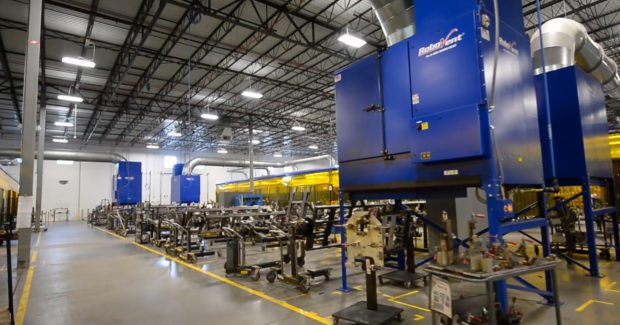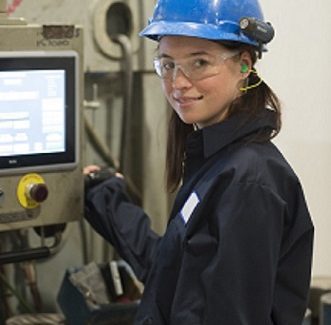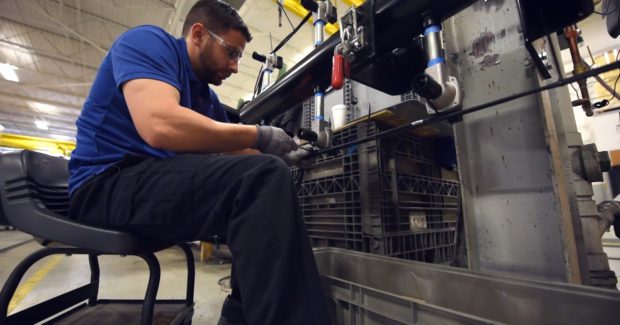Millennials in Manufacturing: Recruiting, Retention and the Factory Environment
If you work in a manufacturing environment, chances are when you come to work you see lots of grey hair. According to the U.S. Department of Labor, more than half of skilled manufacturing workers are now 55 and older – and getting closer to retirement every day.
Posted: February 16, 2017
Clearly, as an industry we need an influx of young blood to keep our facilities humming along at maximum productivity. But many young people entering the workforce are not considering manufacturing and skilled trades. This has already led to skilled labor shortages in some areas of the country, which are expected to grow as the Baby Boomers retire. Recruiting and retaining Millennials (those born in the 1980s and 1990s) and the younger generations coming up behind them will be a critical competitive issue for companies in the coming years. We work with manufacturers all over North America and hear these concerns from our customers regularly. We are also a manufacturer ourselves. Here’s what we’ve learned about recruiting and retaining younger workers and the importance of the workplace environment.
THE COMING LABOR SHORTAGE
A report issued by The Manufacturing Institute (Washington, DC) and Deloitte (New York, NY), The Skills Gap in U.S. Manufacturing: 2015 and Beyond, estimates that between now and 2025 the U.S. manufacturing sector will need to fill 3.5 million jobs due to baby boomer retirements, economic expansion and reshoring of production facilities. The same report predicts that up to two million of these jobs may go unfilled due to skilled labor shortages. Similarly, the American Welding Society (Miami, FL) expects to see a shortage of 290,000 skilled welding professionals by 2020. This is due in part to the changing nature of manufacturing jobs: in most sectors, manufacturers are employing fewer workers overall due to automation – and labor shortages and rising wages are likely to accelerate that trend.
However, many of the jobs that do need to be filled require a higher level of skill than in generations past. Instead of screwing on bolts and assembling parts by hand, today’s manufacturing workers may find themselves interacting with computerized robots and complicated digital control systems. Some of the fastest growing jobs in the manufacturing industry include process control, programming and repair and maintenance of sophisticated machinery. As a result, manufacturers are increasingly finding themselves competing for skilled labor not only among each other, but also with other industries. Young people who have the skill set needed to flourish in today’s manufacturing environment also have many other options available to them, including professional careers that require four-year college or graduate degrees.
Jim Young, a welding instructor in a JATC program for Plumbers and Pipefitters Local Union 495 (Cambridge, OH), says, “We want the ‘A’ student just like the college does. The industry is changing rapidly. We need people who have high skills and business sophistication.” Darren Youngblood, a human resources manager for a large auto parts manufacturer, says his company is feeling the shortage already: “We have trouble finding workers who are willing to work the hours demanded by our industry on a daily basis. We’re spending additional time, money and effort to continue to train employees due to the high turnover.”
WHERE ARE THE MILLENNIALS?
If the jobs are there, why aren’t younger workers flocking to find them? Our industry is struggling with two critical problems: a pipeline problem and a perception problem. Young points to the changing priorities in K-12 education as one reason that fewer students are entering skilled trades. “They don’t have the exposure that they used to,” he says. “High schools are cutting shop classes and vocational programs that used to expose students to these career paths. Guidance counselors are pushing college and these other programs are losing out.” National trends prove his point: the National Center for Education Statistics (NCES; Washington, DC) reports that K-12 enrollment in vocational courses decreased significantly between 1990 and 2009, with especially sharp declines in courses related to manufacturing. Funding for Career and Technical Education (CTE) has been cut at both federal and state levels as more emphasis is placed on academic courses and standardized testing.
Without exposure to up-to-date CTE curricula, many younger people rely on outdated perceptions of factory work when considering career options. Manufacturing facilities in their parents’ generation were often dirty, smoke-filled, unpleasant environments – and those prejudices and perceptions remain. “When I entered the trade, the joke was you retire, get one pension check and then you die,” admits Young, who has worked in the pipefitting industry since 1986. “Pipefitters in the construction industry tended to live six to ten years shorter than someone off the street.” While updated health and safety regulations have vastly improved working environments and health outcomes for manufacturing and construction workers, the perception of these occupations as dirty and dangerous still remains among the Millennials, their parents, and guidance counselors.
CHANGING THE IMAGE OF THE INDUSTRY
Manufacturers need to be thinking towards the future and helping to grow the next generation of skilled trade and factory workers. Partnering with local school systems and setting up formal mentoring or apprenticeship programs can help manufacturers build a pipeline of potential workers in their local areas. However, attention also needs to be given to the workplace environment if we are going to convince these young recruits to stay in the industry. As a group, Millennials are more concerned about working conditions than their parents. That includes both the physical environment as well as social issues, such as management practices, peer interactions, advancement opportunities and company mission.
“There are a lot of hard workers in this generation, but you have to make sure that you take care of them,” explains Martin Reid, the production manager of our Sterling Heights manufacturing facility. “They need more feedback and they expect changes to happen right away.” He says that physical working conditions are also important, including comfort, cleanliness, and health and safety issues. Youngblood also notes how environmental factors play a role in retaining skilled workers at his facility: “We have made several improvements to our facilities for the simple reason of recruitment and retention. We have installed an air purification system to help remove harmful contaminants from the environment. We have plans to expand our break room facilities, bathroom facilities, and other areas in the plant with employee comfort as the main goal.”
We have made workplace environment a priority in our own facilities. When we designed our new Michigan manufacturing plant, one of our primary goals was to make it a place where people love to come to work. This philosophy infused all of the design choices we made for the facility, from the ergonomics of the factory line to the basketball hoop that employees enjoy on breaks. Daniel Lupo, a recent hire, says his impression of our facility impacted his decision to leave another job to come to for us: “It’s a very clean environment. Everything’s very organized and it just feels more comfortable and relaxed.” He also appreciates the attention that is given to health and safety concerns, including overhead cranes that help lift heavy objects and filtration systems that prevent inhalation of dangerous fumes from the plasma cutters. Above all, he values the feeling of respect from his managers. “They make employees feel important,” he says. “They treated me with respect right away.”
CREATING A MILLENNIAL-FRIENDLY ENVIRONMENT
So how can manufacturers improve recruiting and retention for younger workers? There are volumes written on managing the Millennial workforce, but here are some things that have worked for us:
- Keep it clean. At our facility, white walls, good lighting and uncluttered floor spaces make the space feel bright, open and inviting. Organization and cleanliness is a priority to reduce trip and fall hazards and improve productivity.
- Focus on health and safety. Today’s younger workers tend to be more concerned about the potential health hazards associated with welding and other manufacturing processes. Good air quality control, appropriate protective equipment and scrupulous attention to health and safety regulations will let them know that you care about their well-being and are taking care of their health.
- Keep communication open. Respect and communication are very important to Millennials. Providing prompt and respectful feedback and listening and responding to their concerns will go a long way towards reducing conflict and improving retention and morale.
- Help them find a career path. On average, Millennials switch jobs every two years during their first ten years on the job. If you want to keep them around longer, help them find a career path within your organization. Most younger workers are eager for opportunities to improve their skills and continue their education, either formally or informally.
- Make them part of the mission. Millennials tend to be more mission- and purpose-driven than their elders. Make them part of yours. For example, our mission is “Improving Manufacturing Lives Through Clean Air,” and many of our younger workers tell us that’s important to them.
As one employee told us, “When my kids asked me what I do, I explained that I clean air for factory workers. And my kids said, ‘so you save lives!’” We think that’s pretty special.














